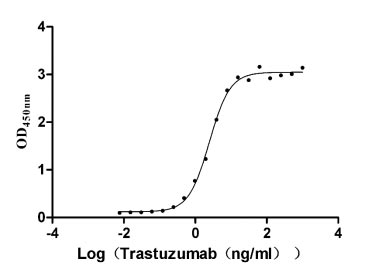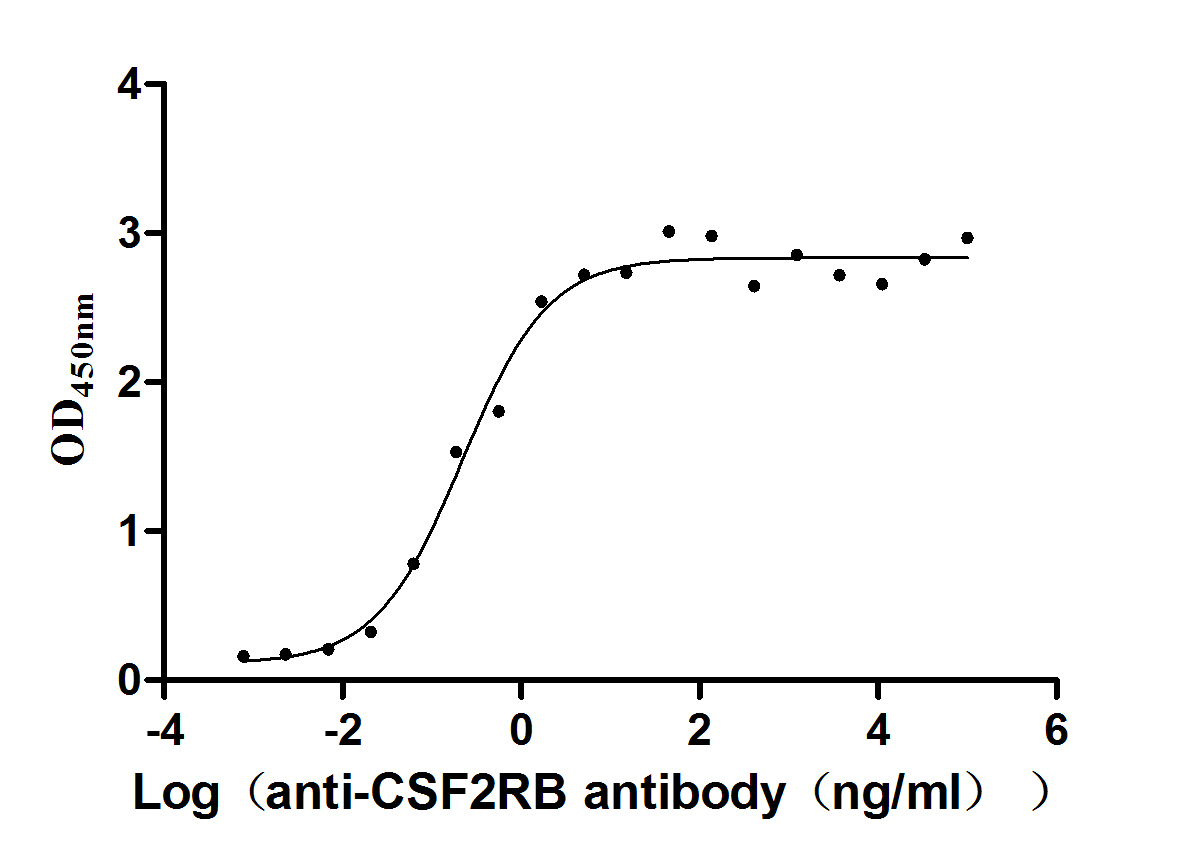Recombinant Rat P2X purinoceptor 2 (P2rx2), partial
-
中文名称:大鼠P2rx2重组蛋白
-
货号:CSB-YP017320RA
-
规格:
-
来源:Yeast
-
其他:
-
中文名称:大鼠P2rx2重组蛋白
-
货号:CSB-EP017320RA
-
规格:
-
来源:E.coli
-
其他:
-
中文名称:大鼠P2rx2重组蛋白
-
货号:CSB-EP017320RA-B
-
规格:
-
来源:E.coli
-
共轭:Avi-tag Biotinylated
E. coli biotin ligase (BirA) is highly specific in covalently attaching biotin to the 15 amino acid AviTag peptide. This recombinant protein was biotinylated in vivo by AviTag-BirA technology, which method is BriA catalyzes amide linkage between the biotin and the specific lysine of the AviTag.
-
其他:
-
中文名称:大鼠P2rx2重组蛋白
-
货号:CSB-BP017320RA
-
规格:
-
来源:Baculovirus
-
其他:
-
中文名称:大鼠P2rx2重组蛋白
-
货号:CSB-MP017320RA
-
规格:
-
来源:Mammalian cell
-
其他:
产品详情
-
纯度:>85% (SDS-PAGE)
-
基因名:
-
Uniprot No.:
-
别名:P2rx2; P2X purinoceptor 2; P2X2; ATP receptor; Purinergic receptor
-
种属:Rattus norvegicus (Rat)
-
蛋白长度:Partial
-
蛋白标签:Tag type will be determined during the manufacturing process.
The tag type will be determined during production process. If you have specified tag type, please tell us and we will develop the specified tag preferentially. -
产品提供形式:Lyophilized powder
Note: We will preferentially ship the format that we have in stock, however, if you have any special requirement for the format, please remark your requirement when placing the order, we will prepare according to your demand. -
复溶:We recommend that this vial be briefly centrifuged prior to opening to bring the contents to the bottom. Please reconstitute protein in deionized sterile water to a concentration of 0.1-1.0 mg/mL.We recommend to add 5-50% of glycerol (final concentration) and aliquot for long-term storage at -20℃/-80℃. Our default final concentration of glycerol is 50%. Customers could use it as reference.
-
储存条件:Store at -20°C/-80°C upon receipt, aliquoting is necessary for mutiple use. Avoid repeated freeze-thaw cycles.
-
保质期:The shelf life is related to many factors, storage state, buffer ingredients, storage temperature and the stability of the protein itself.
Generally, the shelf life of liquid form is 6 months at -20°C/-80°C. The shelf life of lyophilized form is 12 months at -20°C/-80°C. -
货期:Delivery time may differ from different purchasing way or location, please kindly consult your local distributors for specific delivery time.Note: All of our proteins are default shipped with normal blue ice packs, if you request to ship with dry ice, please communicate with us in advance and extra fees will be charged.
-
注意事项:Repeated freezing and thawing is not recommended. Store working aliquots at 4°C for up to one week.
-
Datasheet :Please contact us to get it.
靶点详情
-
功能:Ion channel gated by extracellular ATP involved in a variety of cellular responses, such as excitatory postsynaptic responses in sensory neurons, neuromuscular junctions (NMJ) formation, hearing, perception of taste and peristalsis. In the inner ear, regulates sound transduction and auditory neurotransmission, outer hair cell electromotility, inner ear gap junctions, and K(+) recycling. Mediates synaptic transmission between neurons and from neurons to smooth muscle.
-
基因功能参考文献:
- These data further reveal that the inner and outer ends of adjacent pore-lining helices come closer during opening, likely through a hinge-bending motion. PMID: 26808983
- A trafficking mechanism for 5-HT3A receptor depends on a functional interaction with P2X2 receptor. PMID: 26843630
- This study demonstrated that structural rearrangements of the linker region of the P2X2 receptor channel are induced not only by ligand binding but also by membrane potential change. PMID: 25172943
- Our results suggest that each intersubunit ATP-binding signal is directly transmitted on the same subunit to the level of D315 via the domain that contributes K308 to the beta-14 strand. PMID: 24863932
- Ectodomain movements of an ATP-gated ion channel (P2X2 receptor) probed by disulfide locking. PMID: 24515105
- residues that are in close proximity within the transmembrane domain of rP2X2R PMID: 23936459
- The presence of P2X2 receptors in the majority of noradrenergic cells of the area postrema implies a regulatory role for these receptors in neurons of area postrema. PMID: 22038573
- Based on our immunofluorescence and immunoelectron microscopical studies we believe that both perigemmal and most all intragemmal nerve processes display P2X2-LIR. PMID: 22621423
- High potency zinc modulation of human P2X2 receptors and low potency zinc modulation of rat P2X2 receptors share a common molecular mechanism PMID: 22556417
- The data of this study provided the first direct measures of P2X receptor mobility and show that P2X2 receptors are mobile ATP sensors, sampling more of the dendritic plasma membrane in response to ATP. PMID: 22090499
- these findings indicate that ischemia and reperfusion induces changes in P2X2-ischemia and reperfusion enteric neurons that could result in alterations in intestinal motility. PMID: 21409380
- In silico prediction of Gly72 and Glu167 as ATP-binding residues of the P2X2 receptor strongly supports the validity of homology docking. PMID: 21191044
- The presence of P2X2R immunoreactivity in primarily orexigenic NPY/AgRP/GABA-containing neurons of the arcuate nucleus suggests that extracellular ATP has a regulatory action on this neuronal population located in a strategic position of the brain. PMID: 20736052
- Myocardial ischemic injury induces an increase in expression of P2X(2/3) receptor colocalization with tyrosine hydroxylase and a hypersensitivity state of superior cervical ganglion neurons to ATP, which leads to increased sympathoexcitatory reflex. PMID: 20406659
- Data demonstrate that expression of the P2X(2) receptor is present in inhibitory, intrinsic primary afferent, cholinergic secretomotor and vasomotor neurons. PMID: 20677337
- Review illustrates how density-dependent changes in the P2X2 receptor pore properties have potential implications for physiological regulation by changing the local density of the channel at a synapse and in turn the dynamic properties of the synapse. PMID: 19752115
- A putative extracellular salt bridge at the subunit interface contributes to the ion channel function of the ATP-gated P2X2 receptor. PMID: 20308075
- P2X(1) and P2X(2) receptor subunit involvement in neuronal reaction to axotomy; there is a correlation between purinergic receptor subunit up-regulation and survival of injured neurons. PMID: 12421608
- The interactions that cause expression-dependent changes in P2X(2) receptor properties must involve domains proximal to position H397 PMID: 12604087
- DHEA could be an endogenous modulator of P2X2-containing receptors thereby contributing to the facilitation of the detection and/or the transmission of nociceptive messages, in inflammatory pain where the P2X receptor signalling pathway is upregulated. PMID: 12844512
- immunostaining of pancreas from streptozotocin-diabetic rats revealed P2X1, P2X2, P2Y1 and P2Y2 receptors are expressed in small blood vessels. PMID: 12850289
- regulation of P2X(2) receptor gene expression in the cochlea is adaptive, with sustained loud sound promoting increased transcription and translation specifically at sites regulating hearing sensitivity and auditory neurotrans-mission PMID: 12858039
- modulation of P2X2 receptor function, such as that evoked by acidification of the extracellular environment during hypercapnia, may contribute to the changes in activity of the ventral lateral medulla respiratory neurones PMID: 12878756
- Presence of homomeric P2X2 receptor is demonstrated for the first time in rat otic neurons. PMID: 15081800
- the pore properties of P2X2 channel are not static but change dynamically depending on the open channel density PMID: 15107474
- Results identify a conserved motif in the cytoplasmic C termini of P2X2 and other P2X receptor subunits that is necessary for their surface expression. PMID: 15126501
- Mapping of ATP-gated domains in the transmembrane segments of the P2X2 receptor. PMID: 15317863
- C-terminal domain of P2X2 and the intracellular loop of beta GABAA subunits are required for the functional interaction between ATP- and GABA-gated channels PMID: 15456793
- His120 and His213 sit close to each other across the interface between subunits and are likely to be key components of the zinc binding site in rat P2X2 receptors PMID: 15899882
- results suggest that ATP mainly activates ionotropic P2X2 receptors, resulting in a [Ca2+]i increase dependent on [Ca2+]o in rat myenteric neurons PMID: 15905416
- expression of P2X(2/3) receptors in superior cervical ganglion neurons during late embryonic and early post-natal development PMID: 15973739
- The threefold symmetrical top view demonstrates the first visual evidence of the trimeric composition of the P2X receptor family. PMID: 16219297
- P2X receptor signaling inhibits BDNF-mediated spiral ganglion neuron development in the neonatal rat cochlea. PMID: 17329369
- P2X(2) receptors provide the potential for complex patterns of synaptic integration over a time scale of hundreds of milliseconds PMID: 17664346
- Bladder inflammation sensitizes and increases P2X receptor expression and/or function for both pelvic and lumbar splanchnic pathways, which contribute, in part, to the hypersensitivity associated with cystitis. PMID: 17959738
- the first transmembrane domain contributes little to the permeation properties of the P2X2 receptor PMID: 18048351
- region in the vicinity of Asp(315) is at the plasma membrane interface & N-terminal portion of pre-second transmembrane domain (Arg(304)-Ile(314)) is important for the correct conformation of the receptor at the extracellular face of the membrane. PMID: 18616429
- P2X(2) receptor together with P2X(3) receptor subtype plays an important role in cardiac vagal sensory nociceptors with a sensitivity to adenosine triphosphate (ATP). PMID: 19064335
- The sparse, extended structure of the P2X(2) receptor indicates a loose assembly of subunits, which could be a basis for the activation-dependent pore dilation of P2X receptors. PMID: 19217397
- P2X(2) transcripts and immunoreactivity were detected in approximately 50-60% of geniculate ganglion neuronal somata. PMID: 19266560
- The results imply that the P2X2 gate is formed by residues Asn(333) to Thr(339) and that channel opening involves a counter-clockwise rotation and separation of the second transmembrane domain helices. PMID: 19906973
显示更多
收起更多
-
亚细胞定位:Cell membrane; Multi-pass membrane protein.
-
蛋白家族:P2X receptor family
-
组织特异性:High levels in pituitary and vas deferens. Lower extent in spinal cord, bladder, brain, adrenal, testis, sensory epithelia from the inner ear.
-
数据库链接:
KEGG: rno:114115
STRING: 10116.ENSRNOP00000053533
UniGene: Rn.88799
Most popular with customers
-
Recombinant Human Receptor tyrosine-protein kinase erbB-2 (ERBB2), partial (Active)
Express system: Mammalian cell
Species: Homo sapiens (Human)
-
Recombinant Human Tumor necrosis factor ligand superfamily member 9 (TNFSF9), partial (Active)
Express system: Mammalian cell
Species: Homo sapiens (Human)
-
Recombinant Human Cytokine receptor common subunit beta (CSF2RB), partial (Active)
Express system: Mammalian cell
Species: Homo sapiens (Human)
-
Recombinant Rat Intestinal-type alkaline phosphatase 1 (Alpi) (Active)
Express system: Mammalian cell
Species: Rattus norvegicus (Rat)
-
Recombinant Dog Angiopoietin-2 (ANGPT2) (Active)
Express system: Mammalian cell
Species: Canis lupus familiaris (Dog) (Canis familiaris)
-
Recombinant Macaca fascicularis Claudin (CLDN18)-VLPs (Active)
Express system: Mammalian cell
Species: Macaca fascicularis (Crab-eating macaque) (Cynomolgus monkey)
-
Recombinant Human Lymphocyte antigen 6 complex locus protein G6d (LY6G6D) (Active)
Express system: Yeast
Species: Homo sapiens (Human)
-
Recombinant Human Dickkopf-related protein 1 (DKK1) (Active)
Express system: Mammalian cell
Species: Homo sapiens (Human)









-AC1.jpg)










